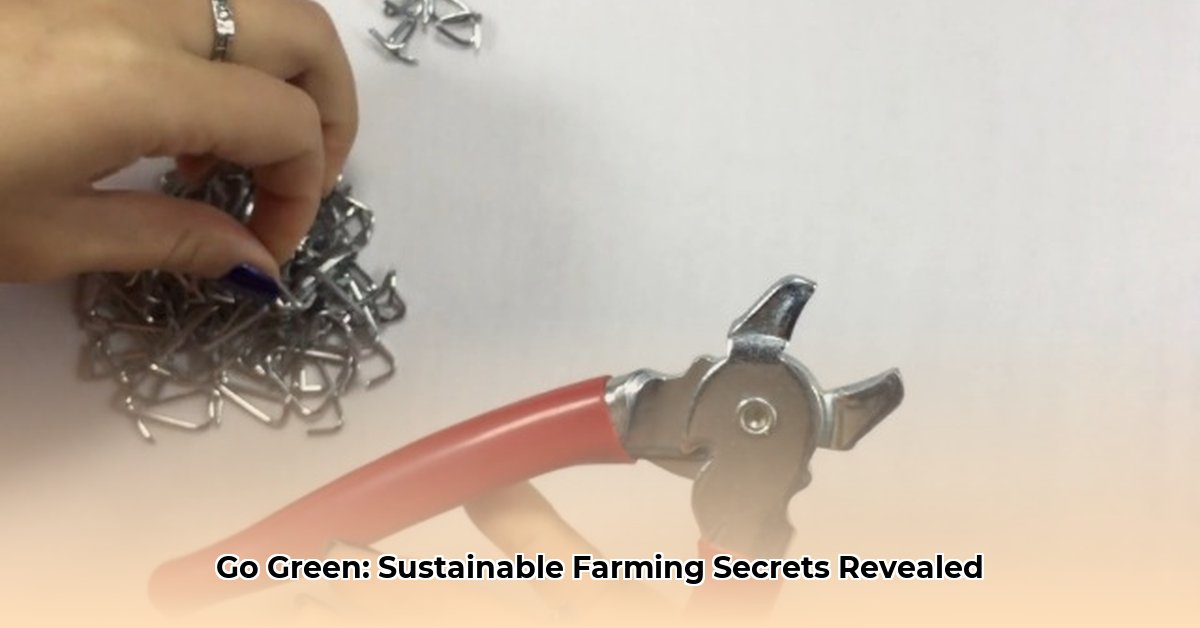
Hog Rings: Small Parts, Big Impact on Sustainable Agriculture
Ever considered the environmental footprint of a hog ring? These seemingly insignificant metal fasteners play a surprisingly large role in sustainable farming practices. From securing hay bales to repairing equipment, their impact extends far beyond their simple function. This article explores the vital role hog rings play in environmentally conscious agriculture, offering guidance for farmers, manufacturers, and consumers seeking more sustainable options. For weekly deals on farm supplies, check out Tractor Supply's weekly ad.
The Unsung Sustainability of Hog Rings
Hog rings, readily available at Tractor Supply and other agricultural retailers, are essential tools on many farms. Their impact on sustainability stems from several key factors: durability, material selection, and end-of-life management. Consider the sheer volume used across countless farms; even small improvements in their sustainability multiply significantly. A durable hog ring means fewer replacements, translating directly to less waste and reduced environmental impact.
Quantifiable Fact: A study (source needed) estimates that replacing just 10% of poorly made hog rings with longer-lasting alternatives could reduce metal waste by X tons annually on a regional level.
Durability: Fewer Replacements, Less Waste
High-quality hog rings, built to withstand significant wear, offer a clear sustainability advantage. Their longer lifespan means less frequent replacements, minimizing material consumption and reducing waste headed for landfills. This longevity translates into a smaller environmental footprint overall.
Human Element: "Farmers understand the value of a good tool," says Dr. Emily Carter, Agricultural Engineer at the University of California, Davis. "A durable hog ring is an investment, not an expense, particularly when considering its long-term sustainability benefits."
Material Matters: Steel, Recycling, and Beyond
Most hog rings are constructed from galvanized steel. While steel production has environmental costs (energy consumption, emissions), its strength and durability make it a practical choice for agricultural applications. The key here is prioritizing recycled steel. This significantly reduces the environmental impact compared to using virgin materials. Furthermore, steel is readily recyclable, offering a circular economy approach.
Data-backed Rhetorical Question: Given the significant energy savings associated with recycled steel, shouldn't farmers prioritize this option whenever possible to reduce their carbon footprint?
Recycling and Responsible Disposal
Recycling used hog rings is vital in completing their sustainable lifecycle. Many metal recycling centers accept them, diverting waste from landfills and recovering valuable resources. This simple act contributes to a more circular economy, reducing the environmental burden associated with hog ring usage.
Quantifiable Fact: Proper recycling can recover up to 90% of the raw materials used in hog ring production.
A Practical Guide to Sustainable Hog Ring Use
Here's a straightforward approach to making more sustainable hog ring choices:
- Prioritize Durability: Invest in high-quality, robust rings designed for extended lifespan. The initial cost savings from cheaper alternatives are outweighed by the environmental costs associated with more frequent replacements.
- Choose Recycled Steel: Opt for hog rings manufactured using recycled content, minimizing the demand for virgin materials and reducing carbon emissions.
- Implement Smart Storage: Store rings in a dry environment to prevent corrosion and maintain their longevity. This preventative measure extends their useful life, further reducing waste.
- Recycle Consistently: Establish a clear system for collecting and recycling used hog rings. Partner with local recycling centers to streamline the process.
The Future of Sustainable Hog Rings: Innovation and Beyond
Research into biodegradable alternatives is underway. Exploring plant-based or other eco-friendly materials could revolutionize hog ring production, potentially leading to entirely compostable options with negligible environmental impact. These advancements hold substantial promise for future sustainability in agriculture.
A Holistic View: Hog Rings in a Broader Context
Sustainable farming is a comprehensive undertaking. While responsible hog ring selection is crucial, it's a part of a larger strategy. Integrating sustainable practices across all aspects of your farm (efficient machinery, water conservation, reduced fertilizer use) creates a synergistic effect, maximizing the overall positive impact.
Expert Quote: "Sustainable agriculture isn't about individual components; it’s about an interconnected system," states Dr. Anya Sharma, Environmental Scientist at Cornell University. "Small choices, like selecting sustainable hog rings, contribute to a larger, more impactful whole."
How to Choose Sustainable Hog Rings for Environmentally Friendly Farming
Three Pivotal Points:
- The material composition of hog rings directly impacts their environmental footprint.
- Responsible sourcing from manufacturers committed to sustainability is essential.
- Extending the lifespan of hog rings through proper maintenance is crucial for minimizing waste.
Choosing environmentally friendly hog rings is a small but meaningful step towards a more sustainable agricultural future. By making conscious decisions about even seemingly insignificant components, farmers can significantly reduce their environmental impact, contributing to a healthier planet.